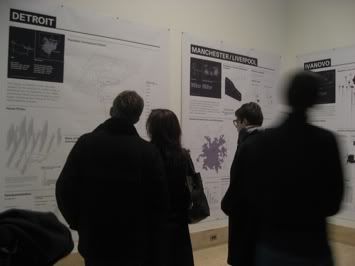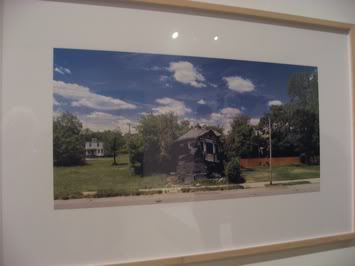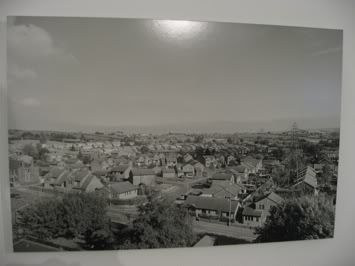Part I: Shrinking Cities @ Cranbrook
I am sure everyone who has heard any local or even national news lately is aware of the seemingly doomed fate of Detroit's Big Three auto industry, especially Ford Motor Company. Despite positive development downtown, this state's future is still uncertain because of the growing abandonment of the industries that helped create it. What will happen to Michigan if the auto companies can't compete and thousands more lose their jobs? Shrinking Cities is a traveling exhibition that focuses on four cities' economic declines and population sprawls.
The above diagram plots out cities like Detroit that once had booming populations which have plummeted since around the time of the late 70's through the early 90's. Other European cities including Leipzig (Germany), Manchester, Liverpool (Britain) and Ivanovo (Russia) are plotted and investigated in this multi-city collaboration art project .






I believe that this four screen video project was the best summary of the exhibition at cranbrook. The four cities, all recorded from a moving car and played simultaneously so that it is hard to decipher which city is which.

Be aware that this exhibition is about taking in information through reading many, many labels, time-lines, diagrams, videos, and charts. It is about informing the public of a situation in history and chronologizing its causes, effects and the solutions: this isn't necessarily about seeing a "pretty art show". I happened to reach a limit though when it came to reading these time intensive labels and charts. I found that the art pieces did a better job explaining the problems than the charts did because it was impossible to read every bit of information. But then I remember that this is at Cranbrook and that everyone experiences exhibitions differently so maybe others will react and understand the charts more than the works...but then I can come full circle again and say, well, this show is at an art museum and not the science center. For many of us who live downtown, work downtown, go to school downtown or frequent the city, this isn't a new subject but I wonder what those who aren't familiar with the city and its decay think? I hope that those who live in the suburbs travel to Detroit to see the second part...after all isn't that what the show is about?


Peter Williams



This time-lapse video shows the four cities and their housing development as it was constructed. In all cities, many buildings pop up around the time of the 50's and then dramatically slow down in the 80's and then disappear in the 90's and 00's. Watching Detroit's housing basically vanish is a really eerie thing!

Mitch Cope - These drawings are about the "barriers" that are constructed to shield urban blight and also keep out big development like factories and strip-malls from neighborhoods. The berms and walls are highlighted in bold red.



Scott Hocking


Clint Snider



Yup, lots of burned out, abandoned, decaying photographs. I understand that this is what the show is about documenting but I have to believe that there are other ways to show this than just lots of photography. Being a Detroit artist means that you have surely come in contact with this imagery many, many times... we all have been influenced by the landscape, so I think that there could have been more variation in visuals. I react most to the Detroit artists' works involved in the show...even if I still think that their inclusion/connections to the show are somewhat "art Mafia" based.

Part II: Shrinking Cities at MOCAD to come....and also Lemberg, CAID, and Detroit Industrial Project posts coming during the week - it was a busy weekend!
The above diagram plots out cities like Detroit that once had booming populations which have plummeted since around the time of the late 70's through the early 90's. Other European cities including Leipzig (Germany), Manchester, Liverpool (Britain) and Ivanovo (Russia) are plotted and investigated in this multi-city collaboration art project .






I believe that this four screen video project was the best summary of the exhibition at cranbrook. The four cities, all recorded from a moving car and played simultaneously so that it is hard to decipher which city is which.

Be aware that this exhibition is about taking in information through reading many, many labels, time-lines, diagrams, videos, and charts. It is about informing the public of a situation in history and chronologizing its causes, effects and the solutions: this isn't necessarily about seeing a "pretty art show". I happened to reach a limit though when it came to reading these time intensive labels and charts. I found that the art pieces did a better job explaining the problems than the charts did because it was impossible to read every bit of information. But then I remember that this is at Cranbrook and that everyone experiences exhibitions differently so maybe others will react and understand the charts more than the works...but then I can come full circle again and say, well, this show is at an art museum and not the science center. For many of us who live downtown, work downtown, go to school downtown or frequent the city, this isn't a new subject but I wonder what those who aren't familiar with the city and its decay think? I hope that those who live in the suburbs travel to Detroit to see the second part...after all isn't that what the show is about?


Peter Williams



This time-lapse video shows the four cities and their housing development as it was constructed. In all cities, many buildings pop up around the time of the 50's and then dramatically slow down in the 80's and then disappear in the 90's and 00's. Watching Detroit's housing basically vanish is a really eerie thing!

Mitch Cope - These drawings are about the "barriers" that are constructed to shield urban blight and also keep out big development like factories and strip-malls from neighborhoods. The berms and walls are highlighted in bold red.



Scott Hocking


Clint Snider



Yup, lots of burned out, abandoned, decaying photographs. I understand that this is what the show is about documenting but I have to believe that there are other ways to show this than just lots of photography. Being a Detroit artist means that you have surely come in contact with this imagery many, many times... we all have been influenced by the landscape, so I think that there could have been more variation in visuals. I react most to the Detroit artists' works involved in the show...even if I still think that their inclusion/connections to the show are somewhat "art Mafia" based.

Part II: Shrinking Cities at MOCAD to come....and also Lemberg, CAID, and Detroit Industrial Project posts coming during the week - it was a busy weekend!



2 Comments:
ART Mafia?!?!?
this was your best Ann
Post a Comment
<< Home